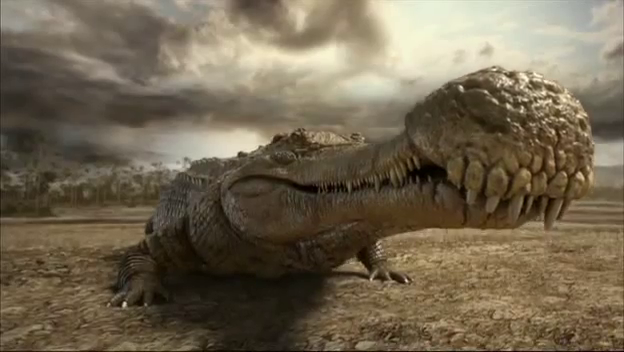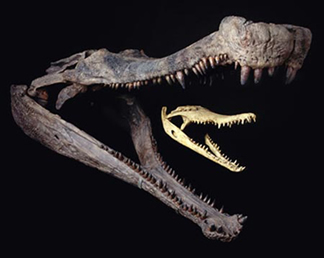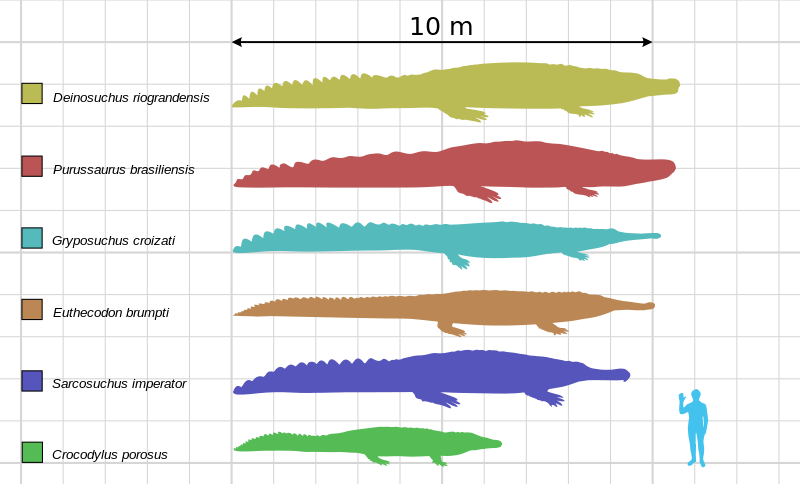Post by Godzillasaurus on Oct 12, 2013 9:58:44 GMT -5

Kingdom- Animalia
Phylum- Chordata
Class- Reptilia
Clade- Crocodylomorpha
Family- Pholidosauridae
Genus- Sarcosuchus
Sarcosuchus was a genus of pholidosaurid crocodylomorph that lived in North Africa and South America during the Early Cretaceous (around 112 MYA). It was one of the largest crocodylomorphs to have ever existed, nearly twice as long as the modern saltwater crocodile and weighing up to, possibly over, 8 tons.
The first remains were discovered during several expeditions lead by the French paleontologist Albert-Félix de Lapparent, spanning from 1946 to 1959 in the Sahara Desert, they were fragments of the skull, vertebrae, teeth and scutes, subsequently in 1964 an almost complete skull was found in Niger by the French CEA but it was not until 1997 and 2000 that most of its anatomy became known to science, when an expedition led by the American paleontologist Paul Sereno discovered 6 new specimens, including one with about half the skeleton intact and most of the spine.
Description
Sarcosuchus was a giant long snouted relative of crocodiles, estimated to have reached a maximum body length of 11–12 metres (36–39 feet), that lived in tropical fluvial and lacustrine environments in Africa and South America approximately some 112 million years ago during the Early Cretaceous period. The orbits of its eyes were somewhat telescoped and its snout comprised two thirds of the total length of the skull, considerably broader than that of narrow snouted crocodyliforms like the living gharial, its upper jaw was longer than the lower jaw, creating an overbite.

Bulla
At the end of its snout, Sarcosuchus presented an expansion, called bulla, it has been compared to the ghara seen in gharials but unlike the ghara, though, which is only found in male gharial, the bulla is present in all Sarcosuchus skulls that have been found so far, suggesting that it was not a sexually dimorphic trait. The purpose of this structure remains enigmatic. Sereno and others asked various reptile researchers what their thoughts on this bulla were. Opinions ranged from it being an olfactory enhancer to being connected to a vocalization device.
Osteoderms
The osteoderms, also known as dermal scutes, of Sarcosuchus were similar to those goniopholodids like Sunosuchus and Goniopholis, they formed an uninterrupted surface that started in the posterior part of the neck up to the middle of the tail like is seen in Araripesuchus and other basal crocodyliforms, different to the pattern seen in living crocodiles, which present discontinuity between the osteoderms of the neck and body
Size
A common method to estimate the size of crocodiles and crocodile-like reptiles is the use of the length of the skull measured in the midline from the tip of the snout to the back of the skull table, since in living crocodylians there is a strong correlation between skull length and total body length in subadult and adult individuals irrespective of their sex, this method is preferred for Sarcosuchus due to the absence of a complete enough skeleton. Two regression equations were used to estimate the size of S. imperator, they were created based on measurements gathered from 17 captive gharial individuals from northern India and from 28 wild saltwater crocodile individuals from northern Australia, both datasets supplemented by available measurements of individuals over 1.5 metres (4.9 ft) in length found in the literature. The largest known skull of S. imperator (catalogue number MNN 604) is 1.6 m (5.2 ft) long an it was estimated that the individual it belonged to had a total body length of 11.65 m (38.2 ft),[1] its snout-vent length of 5.7 m (19 ft) was estimated using linear equations for the saltwater crocodile and in turn this measurement was used to estimate its body weight at 8 tonnes (8.8 short tons). This shows that Sarcosuchus was able to reach a maximum body size not only greater than previously estimated, but also greater than that of ramphosuchus, deinosuchus, and purussaurus, all of which grew to similar sizes.

Classification
Sarcosuchus is commonly classified as part of the clade pholidosauridae, a group of crocodile-like reptiles (crocodyliformes) related but outside crocodylia (the clade containing living crocodiles, alligators and gahrials). Most pholidosaurids had long and thin snouts, and were all aquatic, inhabiting several different environments, some forms are interpreted as marine, capable of tolerating saltwater while others, like Sarcosuchus, were freshwater forms, the most primitive members of the clade, however, were found in coastal settings, zones of mixing of freshwater and marine waters. Sarcosuchus stands out among pholidosaurids for being considered a generalist predator, different to most known members of the clade which were specialized piscivores.
Growth Pattern
Based on the number of growth rings, also known as lines of arrested growth, found in dorsal osteoderms (or scutes) from a subadult individual approximately 80% of maximum adult size, it was estimated that S. imperator reached maximum adult size between 50 to 60 years of age and because crocodilians don't actively grow or live for that long, this suggests that S. imperator achieved its giant size by increasing the duration of rapid growth and not by accelerating the rate of bone deposition like in large mammals and dinosaurs.
Diet
The snout of S. imperator is proportionally long, up to 75% of the length of the skull and while that of juvenile S. imperator resembles the snouts of the gharial and other living narrow-snouted crocodiles, the snout of the adults is considerably more robust and broader. All teeth have smooth and sturdy crowns. It's upper jaw overhangs the lower jaw, leaving a 10 cm (3.9 in) gap between them and when the jaws were shut, with the exception of the enlarged ones, all the teeth of the lower jaw occlude with those of the upper jaw.
These characteristics, among others, contrast sharply with those of the living fish eating crocodylians that possess proportionally narrower and more elongated snouts as well as interlocking teeth, adult S. imperator then, can be compared to large living crocodiles such as the Nile crocodile, possessing a similar generalized diet that also included large terrestrial prey like the abundant dinosaurs that lived in the same region.

Habitat
The remains of S. imperator were found in a region of the Ténéré Desert dubbed Gadoufaoua, more specifically in the Elrhaz Formation of the Tegama Group, dating from the late Aptian to the early Albian of the Early Cretaceous. The stratigraphy of the region and the aquatic fauna that was found there indicates that it was an inland fluvial environment, entirely freshwater in nature, with a humid and tropical climate. S. imperator shared the waters with the holostean fish Lepidotus and the coelacanth Mawsonia, the dinosaur fauna of the region was represented by the iguanodontian Lurdusaurus, which was the most common dinosaur in the region, and its relative Ouranosaurus, there were also two sauropods, Nigersaurus and an unnamed sauropod, the theropods included the long snouted Suchomimus and the smaller carcharodontosaurid Eocarcharia and the abelisaurid Kryptops.
Meanwhile, S. hartti was found in the Reconcavo basin of Brazil, specifically in the Ilhas Formation of the Bahia series, it was a shallow lacustrine environment dating from the late Aptian, similar in age to the habitat of S. imperator, with similar aquatic fauna, including Lepidotus and two species of Mawsonia. The dinosaur fauna is of a very fragmentary nature and identification doesn't go beyond indeterminate theropod and iguanodontid remains.

